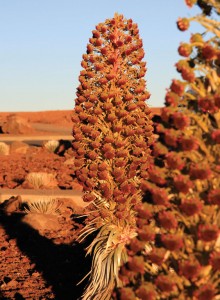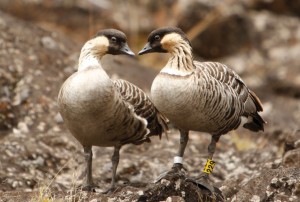Maui’s Magnificent Mountain
Story by Morris Haole, Photography by Joey Corcino
Towering 10,023 feet above sea level, this sacred mountain occupies 75 percent of the Island of Maui and is held in such high esteem it is revered in ancient Hawaiian chants, legends and history. Its majesty beckons with aloha and the traditional Hawaiian greeting: “E komo mai” – “Welcome!”
For centuries native Hawaiians have visited Haleakalā to perform rituals and religious ceremonies, and lay offerings at the sacred caldera. Residents of Maui also make the trek to the summit to greet the sunrise, wearing jackets, blankets and sipping hot cocoa. On August 1, 1916, Congress established the Hawaii National Park consisting of Haleakalā and its sister volcanoes of Kilauea and Mauna Loa on the Island of Hawaii. This arrangement lasted until 1960 when a different Congress declared Haleakalā to be its own unit of the National Park system.
 The designation as Haleakalā National Park has been critical to the environmental health and welfare of the sleeping volcano, bringing federal funding for conservation programs like feral animal control, the maintenance of roads, trails and facilities and educational programs that encourage the public to carefully enjoy the fragile ecosystems and environmental challenges of Hawaii’s “House of the Sun.”
The designation as Haleakalā National Park has been critical to the environmental health and welfare of the sleeping volcano, bringing federal funding for conservation programs like feral animal control, the maintenance of roads, trails and facilities and educational programs that encourage the public to carefully enjoy the fragile ecosystems and environmental challenges of Hawaii’s “House of the Sun.”
The origin of the mountain’s moniker is, according to Hawaiian legend, based on a feat performed by the demigod Maui, whose mother was lamenting that the sun traveled too quickly across the sky. His mother, Hinakawea, was upset that the sun’s quick departure prevented her tapa (Hawaiian barkcloth) to dry. She implored her son Maui, known for his many divine feats of heroism, to reason with the sun to create a longer day. Knowing the attitude of the arrogant sun, Maui secretly fashioned a rope made from his sister’s hair and climbed to the top of the crater in the quiet of the night. In the morning Maui confronted the blazing sun, entreating it to slow its course through the heavens. While the sun was scoffing at Maui’s attempt to negotiate a deal, the demigod suddenly lassoed the sun holding it secure in his snare. “Release me, I beg of you!” pleaded the sun. “No,” Maui replied. “Not until you promise to move slowly and allow the women to dry their cloth.” The sun submitted to Maui’s demand and because it now spent so much time at the summit, the mountain was named Haleakalā, The House of the Sun.
The sunny yet cool climate of Upcountry Maui, with its rich volcanic soils, provides the perfect growing environment for one of the island’s most world-famous crops: the valuable ‘Iliahi, or Sandalwood, which grew profusely on the _ more arid slopes of Haleakalā. As fate would have it, merchant ships arrived and thousands of native Hawaiians were sent to scour the mountain for the fragrant wood, which was harvested and loaded on vessels bound for the orient. So great was the demand for the wood that the landscape was stripped of the endemic trees. Recent propagation effort are helping to slowly restore populations of the Sandalwood, officially known as santalum haleakalae.
The high elevation of Haleakalā makes for cool temperatures even during summer months, and the summit and uppermost slopes often see a dusting of snow – hau kea – during the winter months. Thriving even in such frigid temperatures is the unique ‘Ahinahina, or Silversword plant. Shimmering in the intense winter sun, the hairlike surface of the juvenile Silversword’s silvery leaves are designed to maximize the capture of moisture and protection from sunlight in harsh growing conditions. The argyroxiphium sandwicense will eventually reach a height of six feet, and while it often lives to be 50 years old, it will blossom only once in its life cycle! Thanks to government protection, the threatened plants that were almost trampled to death by curious visitors are now expanding their reach and can be observed in full splendor from July to October along the summit’s roadway, dotting the grounds of the University of Hawaii Astronomical Center and well into the 19 square-mile crater.
Interestingly, the absence of natural predators has allowed many native Hawaiian plants to evolve without thorns, noxious chemicals, unpleasant odors or tastes. Yet as has often been the case in many other parts of the world, humans themselves have caused the most environmental harm, by introducing harmful species that prey on native species and usurp precious food and water resources, or by trampling and over-harvesting. As another benefit from Haleakalā’s national park Status, the Hawaii State Bird – the Nēnē, or Hawaiian goose, has found a protected home on the mountain’s summit, free from the dangers of roaming predators.
Of all the many options of enjoying Haleakalā, perhaps her majesty is best experienced in the quiet moments — a brilliant sunrise, golden sunset, or simply by pulling off the highway and finding a tranquil spot to luxuriate in the rural beauty, catch a glimpse of a rare plant or animal, or simply enjoy the endless vistas and serene contemplation that is the essence of the Maui mindset.
